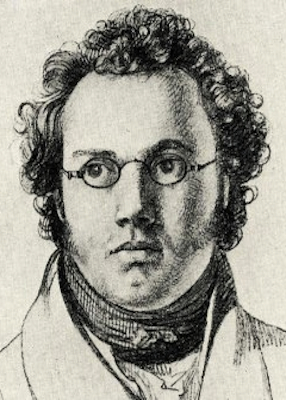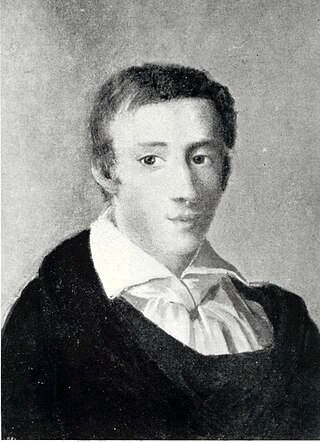
In classical music, a fugue is a contrapuntal, polyphonic compositional technique in two or more voices, built on a subject that is introduced at the beginning in imitation, which recurs frequently throughout the course of the composition. It is not to be confused with a fuguing tune, which is a style of song popularized by and mostly limited to early American music and West Gallery music. A fugue usually has three main sections: an exposition, a development and a final entry that contains the return of the subject in the fugue's tonic key. Fugues can also have episodes—parts of the fugue where new material is heard, based on the subject—a stretto, when the fugue's subject "overlaps" itself in different voices, or a recapitulation. A popular compositional technique in the Baroque era, the fugue was fundamental in showing mastery of harmony and tonality as it presented counterpoint.
Sonata form is a musical structure generally consisting of three main sections: an exposition, a development, and a recapitulation. It has been used widely since the middle of the 18th century.

The Trout Quintet (Forellenquintett) is the popular name for the Piano Quintet in A major, D. 667, by Franz Schubert. The piano quintet was composed in 1819, when he was 22 years old; it was not published, however, until 1829, a year after his death.

Ludwig van Beethoven's Piano Sonata No. 29 in B♭ major, Op. 106 is a piano sonata that is widely viewed as one of the most important works of the composer's third period and among the greatest piano sonatas of all time. Completed in 1818, it is often considered to be Beethoven's most technically challenging piano composition and one of the most demanding solo works in the classical piano repertoire. The first documented public performance was in 1836 by Franz Liszt in the Salle Erard in Paris to an enthusiastic review by Hector Berlioz.
Sonata rondo form is a musical form often used during the Classical and Romantic music eras. As the name implies, it is a blend of sonata and rondo forms.
Sonata form is one of the most influential ideas in the history of Western classical music. Since the establishment of the practice by composers like C.P.E. Bach, Haydn, Mozart, Beethoven, and Schubert and the codification of this practice into teaching and theory, the practice of writing works in sonata form has changed considerably.

Ludwig van Beethoven is one of the most influential figures in the history of classical music. Since his lifetime, when he was "universally accepted as the greatest living composer", Beethoven's music has remained among the most performed, discussed and reviewed in the Western world. Scholarly journals are devoted to analysis of his life and work. He has been the subject of numerous biographies and monographs, and his music was the driving force behind the development of Schenkerian analysis. He is widely considered among the most important composers, and along with Bach and Mozart, his music is the most frequently recorded.
C minor is a minor scale based on C, consisting of the pitches C, D, E♭, F, G, A♭, and B♭. Its key signature consists of three flats. Its relative major is E♭ major and its parallel major is C major.

The Piano Concerto No. 1 in E minor, Op. 11, is a piano concerto written by Frédéric Chopin in 1830, when he was twenty years old. It was first performed on 12 October of that year, at the Teatr Narodowy in Warsaw, Poland, with the composer as soloist, during one of his "farewell" concerts before leaving Poland.
E-flat major is a major scale based on E♭, consisting of the pitches E♭, F, G, A♭, B♭, C, and D. Its key signature has three flats. Its relative minor is C minor, and its parallel minor is E♭ minor,.
A-flat major is a major scale based on A♭, with the pitches A♭, B♭, C, D♭, E♭, F, and G. Its key signature has four flats.
D-flat major is a major scale based on D♭, consisting of the pitches D♭, E♭, F, G♭, A♭, B♭ and C. Its key signature has five flats.
D minor is a minor scale based on D, consisting of the pitches D, E, F, G, A, B♭, and C. Its key signature has one flat. Its relative major is F major and its parallel major is D major.
E minor is a minor scale based on E, consisting of the pitches E, F♯, G, A, B, C, and D. Its key signature has one sharp. Its relative major is G major and its parallel major is E major.
F-sharp minor is a minor scale based on F♯, consisting of the pitches F♯, G♯, A, B, C♯, D, and E. Its key signature has three sharps. Its relative major is A major and its parallel major is F-sharp major.
F minor is a minor scale based on F, consisting of the pitches F, G, A♭, B♭, C, D♭, and E♭. Its key signature consists of four flats. Its relative major is A-flat major and its parallel major is F major. Its enharmonic equivalent, E-sharp minor, has six sharps and the double sharp F, which makes it impractical to use.

Ludwig van Beethoven's Piano Sonata No. 16 in G major, Op. 31, No. 1, was composed between 1801 and 1802. Although it was numbered as the first piece in the trio of piano sonatas which were published as Opus 31 in 1803, Beethoven actually finished it after the Op. 31 No. 2, the Tempest Sonata.

Ludwig van Beethoven's Piano Concerto No. 1 in C major, Op. 15, was written in 1795, then revised in 1800. It was possibly first performed by Beethoven at his first public concert in Vienna on 29 March 1795. It was first published in 1801 in Vienna with dedication to his pupil Princess Anna Louise Barbara Odescalchi, known to her friends as "Babette".
F-flat major is a theoretical key based on F♭, consisting of the pitches F♭, G♭, A♭, B, C♭, D♭, and E♭. Its key signature has one double flat and six flats.

Franz Schubert's last three piano sonatas, D 958, 959 and 960, are his last major compositions for solo piano. They were written during the last months of his life, between the spring and autumn of 1828, but were not published until about ten years after his death, in 1838–39. Like the rest of Schubert's piano sonatas, they were mostly neglected in the 19th century. By the late 20th century, however, public and critical opinion had changed, and these sonatas are now considered among the most important of the composer's mature masterpieces. They are part of the core piano repertoire, appearing regularly on concert programs and recordings.








